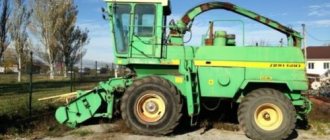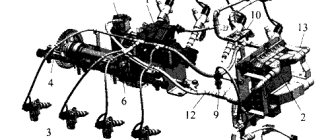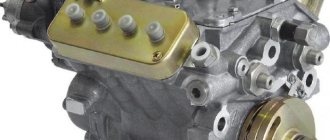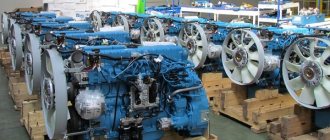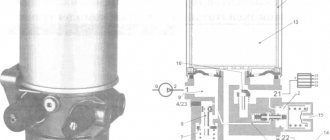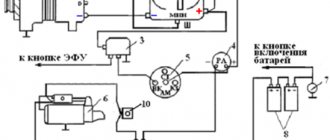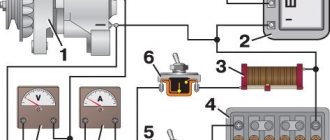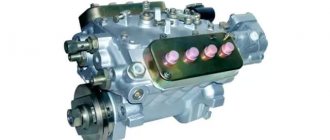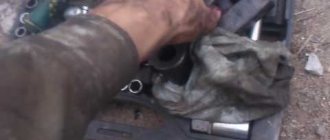KAMAZ fuel injection pump drive rupture
A very common malfunction of diesel equipment, quite familiar to many KAMAZ drivers, is the breakdown of the fuel injection pump drive
, and no one can clearly explain why this happens and how to avoid it.
First, you need to understand that there may be more than one reason, but in different cases there may be several. To understand this, we need to understand what forces act on the drive.
From the side of the box there is a rotating force of the injection pump, and from the side of the pump there is an opposite resistance force. Just like in Newton’s third law: “Bodies act on each other with forces equal in magnitude and opposite in direction.” The harder it is to turn the injection pump, the more torque is applied to the drive, the greater the likelihood of a break.
Now we need to figure out at what moments on the drive side the engine has to exert more force to turn the pump. If you put the pump on the table and try to turn it by hand, it will be very difficult; only with a key you can easily turn the shaft. When it is installed on the engine, connected, pumped, but not connected to the drive, you can try to turn it again by pressing the gas lever. So how? Hard? Now, if you press the jammer and try to turn it... Is it easier?
So, in the first case, we not only turn the mechanism, but also push fuel through the injectors into the cylinders; in the second case, the fuel supply is turned off completely.
The main task of the injection pump is to push a certain amount of fuel into the cylinder at a certain point in time. And it doesn’t matter what the pressure is, because the pump has a specific task, in the form of the amount of fuel, just as the drive has a task to turn the pump no matter what.
The maximum force on the drive occurs at the time of start-up, since the pump pushes the maximum amount of diesel fuel, and in acceleration mode at high speeds, when the injection pump needs to sharply inject a certain amount of fuel, which is needed for traction and acceleration.
If we press the gas and start cranking the pump, we will feel the force that is necessary to push the maximum amount of fuel into the cylinders. If you disconnect the tubes from the injectors and try to twist them again, then of course it will be much easier, so many begin to reduce the pressure on the injectors, thinking that in this way they will reduce the load on the drive, but this is a huge misconception.
Just think about what is happening: at 2000 engine revolutions, the pump makes 1000 revolutions and the same number of injections into each cylinder, this is 1000\60 per second, almost 17 times. Even if we set the injector pressure to zero, the pump still needs to push this fuel through small holes in a short period of time, so reducing the injector pressure usually does nothing. The point is not in the pressure - the pump still presses at higher speeds much more than the opening pressure of the injector, but the point is that the injection pump must push a certain amount of fuel no matter what, and if something interferes with the passage of this fuel, then it is then the load on the drive increases sharply due to water hammer and the drive breaks off. Now we can take a closer look at what could be preventing the passage of fuel from the pump into the cylinder.
Small cross-section of the high pressure tube opening
. When the high-pressure pipes are repeatedly dismantled, the hole is often compressed and naturally impedes the passage of fuel, which in turn causes an increase in the load on the drive.
Slot filter in the nozzle
. There is a piece of hardware in the injector fitting called a “slit filter” - very often this piece of hardware “falls off” under the influence of vibration and begins to cut off the fuel supply.
Jammed nozzles
. If the sprayer is stuck closed, this leads to water hammer.
Coked holes in the sprayer
. If some of the nozzle holes are clogged with carbon deposits, this also impedes the passage of fuel.
The sprayer model does not match this engine.
. For example, there are nozzles 904, and there are 906 - they are absolutely the same and the number of holes is the same, the only difference is in the diameter of the holes.
Source
Blue or gray color of smoke in diesel engine exhaust
A diesel engine can produce white, blue and black smoke from the tailpipe, as well as numerous shades of these colors that are clearly visible in the exhaust. If a diesel engine smokes blue or gray smoke “when cold” and/or “when hot,” then a malfunction of the power unit is quite obvious. The appearance of blue diesel exhaust often indicates two problems:
- violation of fuel atomization efficiency;
- engine oil gets into the diesel engine cylinders;
The fuel injection pump drive on a KAMAZ breaks
Urgent departure in Moscow and Moscow Region Free inspection Guarantee after repair We provide a full range of services
Reasons why the drive on the injection pump breaks:
- when replacing high-pressure pipes in a non-uniform manner, the outlet hole is compressed, which makes it difficult for fuel to pass through;
- the slot filter cuts off the fuel supply;
- jammed nozzles;
- coked holes in the sprayer;
- the pump is incorrectly adjusted, and as a result it produces a lot of fuel.
Troubleshooting:
- replacement of high-pressure pipes in compliance with the parameters of the outlet;
- replacing the slot filter;
- replacement of nozzles;
- adjusting the pump to maintain alignment and take into account vibrations.
If a malfunction is detected, we recommend contacting a service center to diagnose and understand the problem. An independent solution can lead to more serious damage.
- 1) On site (on-site visit of a specialist within Moscow and Moscow Region)
- 2) Service center in Podolsk (Pleshcheevskaya street, 30B)
- 3) Service center in Moscow (Skotoprogonnaya st., 33A, building 1)
Timely troubleshooting will save you from additional waste and major repairs.
Affordable prices
| Name | Price, rubles |
| On-site diagnostics | from 1500 |
| Carrying out an inspection | for free |
| Minor and medium repairs | from 500 |
| Major renovation | on request |
| Replacing a broken part | on request |
for domestic and foreign equipment
Order a calculation
Prices on this website are for informational purposes and are not a public offer as defined by Article 437 of the Civil Code of the Russian Federation
When you shouldn't worry about white smoke
First of all, you need to know that white smoke is normal and has no negative effects. If the white smoke from the chimney is a small amount, there is no need to worry when the smoke disappears after driving the car for a few minutes.
This situation is similar for both diesel and gasoline engines. In the first case, this is because when diesel is cold, it may have difficulty burning fuel. On the other hand, gasoline cars emit white smoke when starting up in winter because the remaining water that is in the exhaust pipe evaporates.
If this is not the case, you need to look into it, because most likely the car has some mechanical problems.
Childhood diseases. Bosch injection pump for Kamaz Euro-2
It's time to touch on the topic of trucks, namely, the familiar Kamaz vehicle. Over the many years of production, it has undergone a huge number of changes and modifications, and to be honest, I can’t even say that it has become better as a result. It became a little, but again, they decided to adapt its already capricious engine to the Euro-2 environmental standard. And then they immediately began to hate this modification; both drivers and repairmen, having learned that it was Euro-2, immediately refused to undertake repairs.
Why is that? The problem is in the high pressure fuel pump. Due to the settings for Euro-2 standards, the unit is entrusted with the task of accurately dosing fuel at the required period. The engine itself is very smoky, especially when starting, the car smokes like a steam locomotive until it warms up. And to prevent this from happening, the pump supplies a very lean mixture. And it turns out that the car has a very small temperature range at which it starts without problems. From practical experience I would say -5 to +5. Yes, this is exactly such a feature of the pump. The lean mixture is simply not enough to start the engine, and you have to turn it more with the starter, and at the same time keep the gas pedal pressed to the floor. Over time, the plungers wear out, become loose, and starting problems begin almost constantly. The engine can start with half a turn when it’s cold, but when it’s hot it won’t start at all, or vice versa.
As we already know, on this modification of Kamaz vehicles, fuel injection pumps are found from two manufacturers - the domestic YAZDA series and the German-made Bosch. Those who don’t know will immediately exclaim: “Bosch would be the best, this is a domestic fuel injection pump that is problematic,” etc., because we are all accustomed to the fact that the Germans always associate this with the word “quality.” But no! In our case, it is the Bosch fuel injection pump that is the culprit of all the problems with the operation of the Kamaz engine. Let's figure out why.
The Bosch injection pump is a unit with an in-line arrangement of plungers and a Common Rail system. According to the developers, it is much more reliable, doses the mixture more accurately and is therefore economical. But the Germans apparently forgot to point out that the pump is very sensitive to the quality of fuel and oil. But we know very well what quality our diesel fuel is. Our “high-quality” fuel, not immediately of course, but kills all filter elements and the driver basically simply does not understand what exactly the problem is. And as a result, repairs require a large sum of money, since imported parts are very expensive.
If we talk about the domestic fuel injection pump, then this is a familiar V-shaped pump, the only difference from the previous ones is the adjustment to Euro-2 standards. Its advantage is that it is able to swallow diesel fuel, so to speak, of any quality and at the same time last longer than the imported version of the injection pump.
And so drivers, faced with all the delights of a German pump, buy a domestic one and simply change it. But this does not always work out, since not all engines have mounts for both pumps. It happens that when the engine is equipped with a Bosch fuel injection pump, it will not be possible to install a domestic one, so these fasteners have to be welded on. To avoid this, I recommend that before purchasing this car with a Euro-2 modification, you reconsider your priorities and it is best to purchase one with a domestic pump.
There is another problem associated with both injection pumps - the lubrication system. On such KamAZ vehicles, fuel injection pumps are included in the general lubrication system. And the Kamaz engine is very problematic, in terms of the fact that there are a lot of rubber bands, something is constantly leaking, it is not surprising that antifreeze gets into the lubrication system and two levels can be seen on the dipstick. And precisely for this reason, many vagaries with the start and operation of the engine are associated with oil getting into the fuel injection pump along with antifreeze.
My father had to work for some time on Kamaz with German fuel. In addition to the fact that it was difficult to start, the engine sputtered and stalled very often. When the engine once again stalled, we discovered that the rack that rotates the plunger does not move at all, that is, it turns out that all the plungers are jammed. Then, when the engine cools down, the rack moves again and the engine starts - miracles! At the same time, there were no two levels of oil on the dipstick, but it was watery to the touch, which is completely strange for oil. We decided to replace it immediately: we drained the oil, and while we were unscrewing the pan, droplets of antifreeze were visible at its bottom during removal. Everything immediately became clear. As it turned out, if antifreeze gets into the injection pump with oil, deposits remain on its plungers, which are very difficult to wash off, and when there are too many of them, at high engine temperatures, they simply jam.
In order for the Kamaz to be driven to a repair site in another city, it was necessary to temporarily fill the cooling system with water. The craftsmen completely overhauled the engine, replaced all the rubber bands and filled in new oil, and turned off the oil supply points to the injection pump so that no lubricant from the engine would enter the pump, but it would be lubricated by what was in it. The pump itself was disassembled, washed and now everything works as it should. I say this because it is better to immediately turn off the oil supply to the pump, even if there is no coolant in the engine lubricant yet. It won’t get any worse, but you will protect yourself and your wallet from problems and extra costs.
How to correctly set the ignition on a YaMZ 7511 engine
Permissible dimensions of the piston assembly gapsThe process of calibrating the gaps of the piston assembly of the YaMZ 7511 engineEvaluation and calibration of the fuel injection advance angle of the YaMZ-7511Calibration of fuel equipment on the YaMZ 7511 engine
For owners of trucks with a YaMZ 7511 power unit, it is necessary to correctly set the fuel injection advance angle (FIA). This is required for the normal and high-quality operation of all transport. How to correctly set the ignition on the YaMZ 7511 will be discussed further.
It is necessary to assess the condition and calibrate the thermal slots of the piston assembly before starting it, as well as after running it in, but not earlier than 15 minutes after the internal combustion engine (ICE) has stopped.
Before you begin calibrating the slots, you need to activate the fuel supply with the regulator bracket, and you also need to remove the valve covers of the YaMZ 7511 cylinder heads. Using a torque wrench, evaluate the degree of tightening of the washers securing the rocker arm axles.
Permissible clearance dimensions of the piston assembly
When you are going to adjust the piston clearances of the YaMZ power unit, as well as during their next analysis, the rocker arms are pressed according to the location of the cylinder heads.
- Right side row. Press the exhaust pistons against the front part of the axle, and the intake pistons against the locking rim.
- Row on the left side. The outlets are to the locking rim, and the inlets are to the frontal part of the axle.
Reference! The exhaust pistons on the right are installed closer to the cooler, and those on the left are the opposite.
To adjust the slots, you need to slightly unscrew the calibration bolt washer. Next, place the probe in the slot and set the free space within 0.25 - 0.30 mm; to do this, you need to twist the bolt using a screwdriver. After installation, you need to tighten the washer; to do this, you also need to support the bolt with a screwdriver. After tightening, a probe with a size of 0.25 should easily pass into the gap, and a 0.3 mm probe with force.
It is worth noting that due to the possible runout of the contacting elements of the gas distribution mechanism (GRM) when the crankshaft rotates, after calibrating the pistons, an opening within 0.2 - 0.4 mm is allowed.
The process of calibrating the slots of the piston assembly of the YaMZ 7511 engine
The adjustment of the slots is determined by the operating sequence of the cylinders. For the YaMZ 7511 272 engine – 1-5-4-2-6-3-7-8. The setup procedure is as follows.
Cylinder torque problem #1:
- using a special key, turn the crankshaft from left to right (relative to the fan);
- At the same time, you need to monitor the activity of the intake piston of cylinder No. 1;
- the moment is established when the valve completely rises, in other words, closes;
- then the shaft must be turned another third of a turn.
Cylinder No. 1 now undergoes a compression process with both pistons closed.
To calibrate the slots of the next cylinder you need:
- rotate the crankshaft in the direction of torsion until the pistons of the adjusted cylinder are completely closed;
- then perform another third of a turn.
Further calibration of the pistons of the YaMZ power unit must be carried out similarly to the indicated points.
Evaluation and calibration of the YaMZ-7511 fuel injection advance angle
To adjust the UOVT, there are a pair of hatches on the flywheel housing of the YaMZ 7511. On the disk itself there are corner markers at two points: for the bottom pointer this information is indicated in numerical format, for the side pointer - in alphabetic format.
Certain letters correspond to certain parameters:
- “A” – 20th;
- “B” – 15s;
- "Ei" – 10D;
- “G” – 5s.
Advice! The fuel injection advance angle should be 6J*1.
It is necessary to turn the crankshaft from left to right (from the cooler side) until the line on the disk that corresponds to the UOVT is aligned. It is worth noting that the pistons of the first cylinder must be closed.
As mentioned earlier, you need to turn the crankshaft using a special wrench using the pulley fixation screw. The flywheel mark must align with the pointer mark. If the combination does not occur, then you should do the following:
- loosen the screw of the terminal connection;
- by twisting the damper, align the strokes;
- carefully fix the bolt.
In this case, the deviation of the plate package from the position in one plane is permissible by 1 mm in both directions. The deviation must be measured at the places where the plates are fixed.
Calibration of fuel equipment on the YaMZ 7511 engine
After setting the ignition on the YaMZ 7511 and warming up the engine to normal operating temperature, calibration is required. First you need to set the power at a crankshaft torque intensity of 1900 50 min-1. Its indicator for the YaMZ 7511 power unit is 290+4 kW, while the hourly fuel consumption is no more than 66 kg/h. When finished, push the cap washer onto the power calibration bolt until it stops.
Reference! To maintain the required temperature of the fuel when measuring flow, it is necessary to prevent the volume of liquid from decreasing to less than 2/3 of the height of the container.
In addition, timely and thorough lubrication is responsible for the condition of the motor. Special attention must be paid to the YaMZ 7511 oil pump. If necessary, it is worth repairing or replacing.
Now there should be no questions about how to correctly set the ignition on the YaMZ 7511. You can carry out the procedure yourself. If you are not confident in your abilities, be sure to contact the service center. Qualified technicians will help resolve your problem for a fee. When setting up on your own, there is a high chance of making a lot of mistakes.
18.04.2019
Source: https://b2b.rumotors.com/review/kak-pravilno-vystavit-zazhiganie-na-dvigatele-yamz-7511
KAMAZ drive, Why does the drive break?
Contacts on the website https://tnvd.org Subscribe under the links Instagram https://www.instagram.com/tnvdorg/ TNVD-ORG channel https://www.youtube.com/c/TNVDORG Group in contact https:// vk.com/tnvdclub KAMAZ drive, Why does the drive break? https://www.youtube.com/watch?v=FgIqP9mu4qo Add to the group in contact https://vk.com/tnvdclub and in Odnoklassniki https://ok.ru/group/53464780833003 Phone\whatsapp, only for questions dispatch and repair of fuel equipment: +7-960-46-12345 Call during business hours from 8:00 to 17:00 Moscow time on weekdays Hello everyone, this is the fuel equipment master - Roman. Today we will talk about such a problem on KamAZ vehicles, especially on Euro-2 engines, and especially with this Bosch pump, about such a problem as the plates tearing, the drive breaking. There are frequent cases of why it tears and not very frequent ones. Of course, the first thing is the centralization of the pump, i.e. how it is aligned with the drive along the axis. If some kind of dirt gets under the fastenings, then it will stand crooked - there will be vibration and the plates will break. Next there is a nozzle; our smart engineers began to install a slot filter on the nozzle. Here is the nozzle - there is a slot filter here. Very often, this slot filter is knocked out, it rests on the hole from which the fuel oil passes, it becomes flared, and then the fuel oil passes through poorly. And also - this also happens often - there is a bone coming from the pump, the bone goes into the engine and there is a bearing there, so if it is loose, then the drive also very often breaks. But at the same time, the oil seal also begins to leak oil. that's all, the rest needs to be looked at on the car. I think everyone can figure this out. I explained the meaning - why torque is generated on the pump, precisely because of the amount of fuel. Good luck, try it, figure it out - everything is simple here. Fuel equipment master Roman Firsov was with you. KAMAZ drive, Why does the drive break? Visit my website and find out more information. Subscribe to my channel https://www.youtube.com/c/TNVDORG https://www.youtube.com/watch?v=FgIqP9mu4qo Add to the group in contact https://vk.com/tnvdclub and in Odnoklassniki https ://ok.ru/group/53464780833003
Video KAMAZ drive, Why does the drive break? channel TNVD ORG
Source
Blue smoke: wear of the cylinder-piston group
The most common reason that a diesel engine produces blue smoke is wear of the cylinder-piston group and timing parts. Oil entering the combustion chamber may occur due to increased piston ring gaps, gaps between valve stems and guide bushings. Damage may occur on the cylinder liner; rings, piston grooves, etc. may be destroyed.
The presence of strong gaps in the area of the piston grooves causes oil to be “sucked” into the combustion chamber. This happens even taking into account the normal condition of the oil scraper rings. Additionally, the shape of the cylinder can change, which significantly reduces the sealing by means of rings. The cylinders may take on the shape of an ellipse, resulting in gaps appearing. Wear of the CPG causes loss of compression, and crankcase gas pressure also increases. When measuring compression, it must be taken into account that the oil in the cylinders can seal the gaps. It turns out that the compression in the faulty cylinder will be too high. To obtain accurate results for assessing compression and the state of the CPG, a number of specific requirements must be met.
If the CPG is not worn out much, then blue smoke is clearly visible during the engine warm-up process. After reaching operating temperature, the smoke intensity decreases or the blue diesel smoke completely disappears. This is explained by the expansion of parts as a result of heating, which causes sealing of the gaps. An example is that diesel is bad, but a repeated hot start occurs without problems.
Oil consumption increases as a result of breakage of the bridges between the piston grooves. An increase in engine oil consumption results from broken rings as a result of wear or overheating of the diesel engine. Using low quality oil and not changing it on time leads to stuck piston rings. The rings “stick” in the piston grooves, and their mobility is completely lost.
Direct (excessive oil consumption) and indirect signs help identify oil getting into the cylinders due to CPG wear. The second group includes: the appearance of noise from the operation of the engine, various knocking sounds appear with changes in speed and load on the engine, the intensity of blue or gray smoke changes as the engine warms up, unstable operation of the diesel engine is noticeable when starting “cold”.
Bosch Kamaz Euro 2 fuel injection pump drive is tearing
KAMAZ drive, Why does the drive break?
Why does the KamAZ fuel injection pump drive break and how to fix it?
KamAZ injection pump drive Part 2.
Kamaz drive. Why does the drive break? Addition to part 1
KAMAZ REPAIR oil in the camber of the injection pump drive
replacing BOSCH fuel injection pump with KAMAZ fuel injection pump! ALL KAMAZ vehicles are equally different! Kamens motor assembly
How to change the fuel injection pump drive oil seal
How to set the ignition on a diesel engine (injection timing)
Section for commenting on faults and problems. Engine.
Repair
,
maintenance
and
device
,
engine malfunctions of a KAMAZ vehicle
.
Here we discuss problems with the engine of a KAMAZ vehicle, upon request from the comment:
I’ve been keeping KamAZ 65117 2006 (740 30 260) for a year now, during this year I removed the pump 2 times for minor repairs, mainly flushing the injection pump due to antifreeze getting into the oil (replacing liners and rubber bands), over the last six months: 1. breakage of plates — replacement of the drive gear and bearing assembly (replaced because the fuel injection pump drive cover broke off twice), the key was cut off twice in the area of the small plates where the bolt is. 3. Yesterday I got on the highway again (you turn the injection pump drive with the starter and it’s still in place). Tomorrow I’ll disassemble it, but most likely it’s a key again.
Tell me what to do to avoid “problems with the drive”.
There are opinions about replacing the fuel injection pump with V Russian Evra 2.
I found recommendations (but it’s not clear what to do)
The operation of diesel power plants is directly related to the supply of the fuel mixture to the combustion chamber; the KamAZ Euro 2 injection pump plays a major role in this action. A breakdown or failure of the fuel pump will immediately affect the operation of the engine, or even stop the unit altogether. Structurally, the pump is a reliable and durable mechanism, however, the fuel sold at gas stations often does not meet the required characteristics and subjects the product to increased loads.
Today KamAZ engines do not meet Euro-2 standards. Non-compliance with environmental standards was the reason for the cessation of production of units in 2006. However, the operation of engines is not prohibited; KamAZ vehicles with similar units are still in demand and travel across the vast expanses of the country. It is not surprising that installing fuel injection pumps on KamAZ Euro 2 is still of interest to users.
Diesel engine smokes blue smoke: reasons
Every car owner may experience one very interesting, incomprehensible headache in the form of smoke from the exhaust pipe, and especially owners of cars with a diesel unit. It seems that the car will drive and work, but the fact that it smokes will not leave its owner any peace.
The situation is interesting because the smoke can be of different colors: black, white, gray or smoke blue smoke, blue smoke is the most common. And for a certain reason, there will be smoke of a certain color.
The cause of black smoke may be fuel that has not burned completely. Smoke of this color occurs when there is an excessive supply of fuel or the fuel is of poor quality. A lack of oxygen will have the same effect. The same reasons are involved in the appearance of gray smoke. The smoke is gray in color only because the defects are not as serious as those that cause a black trail behind the car.
A diesel engine emits bluish smoke and there may be different reasons for this. If blue smoke is emitted while the car is running on a cold engine or an already warm one, then you should think about problems in the diesel unit. This effect can be caused by two problems:
- The fuel does not burn out.
- Engine oil enters the engine.
To understand why a diesel engine smokes, you need to diagnose it without resorting to the help of special devices. You can identify the problem by the degree of smokiness and the smell it carries.
Types, purpose and principle of operation of injection pump
As already mentioned, without a fuel pump, the operation of a diesel power plant is not possible. In engines of this type, the unit is entrusted with the task of dosing diesel fuel and supplying it to the combustion chamber at the right time. In addition, the pressure with which the portion is delivered is also important. The requirements complicate the work algorithm and force us to operate under increased load conditions.
KamAZ power plants, with an environmental class corresponding to Euro 2, use high-pressure pumps of several brands. Among manufacturers, the “lion’s” share falls on fuel injection pumps of the YAZDA series, used on KamAZ Euro 2. Products of the modification “337.20” are produced by a machine-building enterprise located in the city of Yaroslavl. The product is popular and accessible primarily due to its pricing policy. In addition, reliability and simplicity make the pumps less demanding, and balances the disadvantage associated with the accuracy of fuel dosage. Second place goes to the imported Bosch injection pump, installed on KamAZ of Euro 2 standard. The product is distinguished by its quality and accuracy, but there are often complaints about the pump drive, which does not withstand operating conditions.
It's all about oil
With this diagnosis, the “cloud” from the exhaust pipe will smoke from light to dark shades. It will depend on the concentration of oil that flows into the combustion chambers, engine operating conditions and warm-up temperature. At the same time, you will feel the burnt smell characteristic of the oil.
The appearance of such gas will be indicated by increased oil consumption. To solve this problem, you need to decide on suppliers of “unnecessary” fluid.
Wear of the cylinder-piston group
Very often, a diesel engine produces bluish smoke due to wear of the cylinder-piston group and timing components (gas distribution mechanism). Oil can get into the cylinder for several reasons.
- The piston ring clearances have been increased.
- The gaps between the valve stems and guide bushings have been increased.
- There is damage on the cylinder liner.
- The rings are destroyed.
- There are violations of the piston grooves and many other reasons.
For example, severe gap defects in the area of the piston grooves allow the combustion chamber to “suck” oil. This is possible even if the oil scraper rings are in good condition. With a long period of operation, the cylinders can change their shape, for example, become elliptical. Due to changes in shape, compaction deteriorates.
Wear of this group of parts also causes a decrease in compression. When measuring compression, it is worth taking into account the ability of the oil to seal gaps. It turns out that if the cylinder is faulty, then the compression should be too high. To carry out diagnostics of the CPG (cylinder-piston group), take measurements and obtain an accurate assessment, certain requirements must be met.
If the mechanisms do not have a very large deterioration in quality, then the notorious smoke can be seen when the engine warms up. After warming up, the level of the symptom decreases or disappears completely. This is explained by the fact that at high temperatures the parts expand and the gaps become sealed.
skeleton
The frame of the Bosch pump contains the parts necessary for the functioning of the mechanism: pump sections, a shaft with cams, and a rotation impulse regulator. The material of manufacture is aluminum alloy, from which the intake and shut-off channels are cast, as well as voids for mounting the pump sections, bearing shaft, regulator drive gears, fuel inlet and outlet fittings. The flank end contains a regulator plug with a reduced pressure pump. The plug has a fitting through which the injection pump is lubricated under pressure.
A cover is placed on top of the empty frame, to which mechanisms are attached that control the number of revolutions of the regulator and the fuel section plate. A pipe with a valve in the form of a ball is installed in the front part of the frame. The product maintains diesel fuel pressure within 0.06 to 0.08 MPa. The bottom of the frame contains a void into which a shaft with cams is installed.
KamAZ high pressure fuel pump:
The procedure for checking and adjusting the amount and uniformity of fuel supply
Check the pressure at the start of opening of the injection valves, which should be (0.02…0.1) MPa [(0.2…1.0) kgf/cm2]. The pressure control of the start of opening of the injection valves is carried out at the moment the fuel begins to flow out of the fuel line with an internal diameter of (2±0.05) mm with a gradual increase in pressure at the inlet to the fuel pump and the position of the rack corresponding to the fuel supply being turned off.
2. Check the fuel pressure in the line at the inlet to the fuel pump. The pressure should be (0.175±0.025) MPa [(1.75±0.25) kgf/cm2] at the rated speed of the camshaft and the control lever resting on the maximum speed limit bolt. If necessary, unscrew the bypass valve plug and adjust the opening pressure using washers.
3. Check the rack's power reserve. By rack power reserve we mean the free movement of the rack (backlash) in the direction of turning off the feed at 450-600 min-1 and when the governor control lever rests on the bolt for limiting the minimum rotation speed. If there is no power reserve of the rack, it is necessary to unscrew the power adjustment screw all the way and then use the rocker bolt to adjust the power reserve of the rack within 1-1.3 mm and lock it. Attention! Protrusion of the rocker screw beyond the outer end of the regulator cover is unacceptable.
Shaft with cams
The shaft with cams transmits displacement to the plungers of the pump sections, diesel fuel is supplied to the chambers at the right time. The shaft is made of steel, the loaded surfaces are calcined with cement powder to 0.7-1.2 mm, rotation occurs through two bearings. The shaft is protected from leaks by a cuff, the material of the product is rubber. The front end of the shaft drives a clutch that sets the diesel injection angle. Rotating, the shaft transmits pressure to the pushers and then to the pump plungers through the heels. By changing the thickness of the heels, we influence the nature of the fuel supply; an increase in thickness provokes an early supply and vice versa.
Reasons why the engine emits white smoke
Fuel enters the diesel unit by injection into the cylinders through injectors. As diesel fuel moves, a fuel mixture is formed inside the injectors. As a result of this phenomenon, diesel fuel is evenly distributed in the space of the engine cylinder into small particles. Then, these microscopic particles of fuel in the cylinder heat up and begin to actively evaporate.
A four-stroke engine running on diesel fuel, in fully working order, should produce exhaust gases that are completely colorless. This should be so for one simple reason: the atomized portion of diesel fuel exactly corresponds to the norm for a cylinder of a given volume. Its injection through the injectors occurs at the moment of maximum compression, which contributes to the complete combustion of the fuel mixture. As a result of precise operation, the diesel power unit produces maximum power. If the engine starts to smoke white, it means that the following negative changes have occurred:
- the humidity in the diesel engine has increased significantly;
- not all of the fuel mixture burns;
- Coolant in the cylinders.
The reason is condensation
For a diesel engine that is warming up, white smoke is not a rare phenomenon and is quite acceptable. The whole problem is in the water that condenses in the exhaust pipe after the car is idle. When the car engine starts, some of the water is pushed out by the exhaust gases. Water drips from the pipe. It looks like water has been added to the diesel fuel. The remaining water evaporates when the pipe is heated. In warm weather this is not noticeable. It's a different matter in winter. At sub-zero temperatures, the engine warms up longer, therefore, the steam formation process is delayed. Therefore, when the engine warms up, white smoke is visible coming out of the exhaust pipe. It should be noted that this applies not only to diesel engines, but also to gasoline engines.
Pump departments
The pump section dispenses and supplies diesel fuel to the nozzles. Each unit includes a frame, a plunger pair, a rotation sleeve, elastic elements of the plunger, a discharge valve and a pusher.
The frame is equipped with a flange that secures the section to the pump using studs. The pin holes are oval in shape; it is possible to adjust the uniformity of diesel supply to each compartment individually (turning clockwise reduces the supply, and vice versa). The plunger pair is directly involved in cutting off and transporting diesel fuel and consists of a sleeve and a plunger. The parts are precision made, the material is steel with the addition of chromium and molybdenum, followed by hardening and cooling with nitrogen. The plunger acts as a piston, has axial drilling and radial grooves that change the flow of diesel fuel. The precision pair of discharge valve and seat are made of steel, after the elements are hardened and cooled. Replacement of components is possible only as an assembly.
KamAZ injection pump cam shaft:
Air preparation system
The air preparation system includes an air filter and an intake pipe. It can be supercharged or without it. Air enters through the intake pipe into the air filter and then through the intake pipe into the engine cylinders.
The air filter (Fig. 1) consists of a housing 3, a cover 1 and a replaceable filter element 2, consisting of two perforated steel casings and corrugated cardboard between them.
Air purification in the filter is two-stage. The first air purification is a monocyclone, which consists of a damper behind the pipe 5, which ensures rotation of the air flow around the filter element 2, thus purifying the air from dust that collects in the hopper.
The dust collection bin is formed by a lid 1 and a removable plug. Connection 7 is designed to suck dust from the filter housing. The second stage of cleaning is filter element 2. Air enters the filter through pipe 5, is cleaned there and exits through pipe 6.
The durability of engine crankshaft parts largely depends on the quality of air purification, so the condition of the filter elements should be carefully monitored and replaced in a timely manner. On KamAZ vehicles, a control sensor for air filter clogging is installed in the driver's cabin, which signals the need to replace the filter element.
***
Speed control device
The KamAZ Euro 2 fuel injection pump design provides for the use of a speed control mechanism. The fact is that for stable operation of the power plant, a steady state is required. The parameter provides for constant rotation of the shaft, heating of the lubricant, etc. To achieve the indicators, the values of the torsion impulses and counter-motion impulses are equalized. Operation upsets the balance, since the applied force in the modes differs, as a result, the parameter values deviate from the required ones. The return of impaired indicators is possible thanks to adjustment. The process takes place manually (fuel pump rail), or using an automatic machine that regulates the frequency. The last element maintains the user-suggested shaft speed by changing the portion of diesel fuel taking into account the load in automatic mode.
KamAZ engines are equipped with a direct type control device, installed in the frame of the pump with adjustment on the plug.
- A device that sets the required value of the controlled variable;
- Device for perceiving an influencing quantity;
- Comparison device;
- Execution device;
- A device that actuates the regulator.
Diagnosis and localization of the problem
In the first case, the exhaust is blue, pungent, and has a pungent odor. The reason is that only well-atomized diesel fuel burns in the cylinder. Drops of unburned diesel fuel fly out of the exhaust pipe in a vaporous state. The other part of the drops burns inside the cylinder, but on the piston itself. This causes severe overheating of the piston, which can lead to melting or burnout.
The culprit of the malfunction turns out to be the fuel equipment of the diesel engine. Often the problem lies in the injection pump and diesel injectors. Smoking from the bluish exhaust when the diesel engine is warming up indicates a malfunction of the glow plugs or a drop in compression in the cylinders.
In the second case, the exhaust takes on a color from whitish-blue to dark blue. The color of the exhaust directly depends on the amount of oil penetrating into the combustion chamber, the operating mode of the internal combustion engine and the degree of engine warming up. The smell of exhaust with a lot of oil is burnt, such smoke takes a long time to dissipate in the air.
The appearance of oil smoke is accompanied by an increase in engine oil consumption. During operation of the internal combustion engine in transient modes, the smoke with impurities of burnt oil is thicker. The catalyst (catalytic converter) of gasoline engines cleans the exhaust of oil even at high consumption. On diesel internal combustion engines, oil exhaust is more noticeable.
Clutch that changes the supply of diesel fuel
The Bosch KamAZ Euro 2 fuel injection pump design and others provide for the introduction of diesel fuel 18° before the piston reaches the top point on the compression stroke. This is done to mix the air and the diesel charge in order to get maximum power.
Increasing the speed of revolutions reduces the time for combustion preparation. To prevent the procedure from starting after the top point and reducing useful work, diesel fuel is administered ahead of schedule, with an increase in angle. This is done with a clutch that changes the supply of diesel fuel by turning the shaft with cams in the direction of circulation in relation to the drive. The clutch improves engine starting and saves diesel fuel.
On KamAZ, the automatic installation uses an adjustment range from 18° to 28°. The product is located at the conical end of the injection pump shaft, fastening is provided by a nut and washer.
- skeleton;
- Main half coupling;
- The secondary half of the coupling;
- Gaskets;
- Glass stops of elastic elements;
- Thrust washers;
- Regulating gaskets.
Source
White smoke from the exhaust pipe of a gasoline engine
As stated earlier, the release of white steam from the exhaust in cold and humid weather is a completely natural phenomenon; before warming up, you can even see it dripping from the muffler, but if the engine is at an optimal temperature, and steam continues to escape, then you can be sure that the engine there are problems.
The main reasons why white smoke comes out of the exhaust pipe of a gasoline engine are:
- Leaking coolant into the cylinder.
- Injector malfunction.
- Low-quality gasoline with foreign impurities.
- Burnout of oil due to the presence of rings (smoke with a tint).
The reasons why white smoke may appear from the exhaust of a gasoline car may only partially differ from those affecting a diesel engine, so we will pay more attention to how to check exactly why the smoke began to pour out.
What is the pressure of KAMAZ 5320 injectors?
Injector pressure. Experience
KAMAZ injectors. How to determine performance? Part 2
KAMAZ injectors. How to determine performance? Part 1
Adjusting the nozzles
KAMAZ injectors
How does the fuel system of a KAMAZ vehicle work?
Super ignition unit (OVT) for KamAZ and MTZ, which has no analogues in the world.
Kamaz “new” pump!!!
Slave. fuel injection pump processes
Oil pressure dropped to almost 0
Also see:
- All about KAMAZ clutch
- Fuel tank capacity KAMAZ 5410
- KAMAZ 343 101
- Setting up a KAMAZ air dryer
- Reviews about KAMAZ 65224
- Models of cars with KAMAZ combustion engines
- Relay breaker for direction indicators and hazard warning lights KAMAZ
- How many cubic meters of snow in KAMAZ
- How to connect an ammeter in a KAMAZ vehicle
- KAMAZ 53215 15 cargo flatbed 2007
- Right wing KAMAZ 5320
- Wheel bearing size KAMAZ 43118
- ABS wiring harness KAMAZ
- Pyatak retractor relay KAMAZ
- KAMAZ 43105 engine model
Home » Popular » What is the pressure of KAMAZ 5320 injectors kamaz-parts.ru
